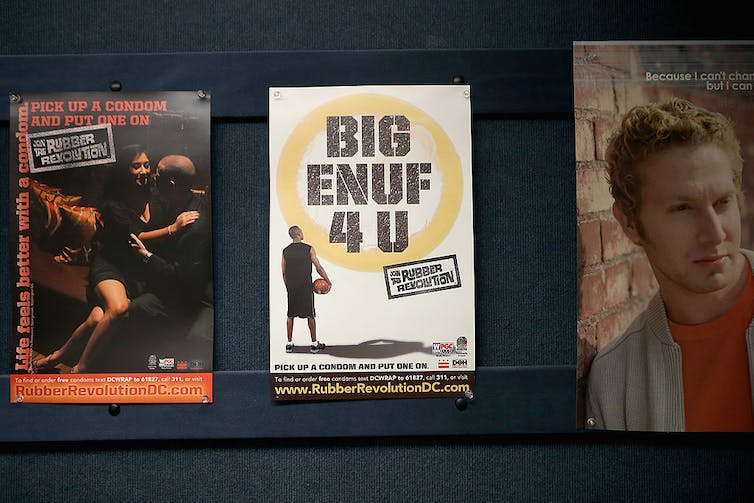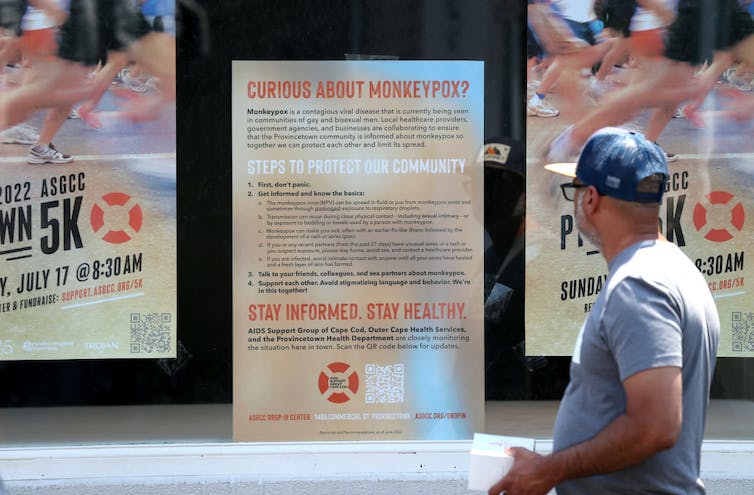
During infectious disease outbreaks, clinicians and public health officials are tasked with providing accurate guidance for the public on how to stay safe and protect themselves and their loved ones. However, sensationalized media coverage can distort how the public perceives new emerging infections, including where they come from and how they spread. This can foster fear and stigma, especially toward communities that are already mistrustful of the health care system.
The racial and sexual stigma surrounding monkeypox is what spurred the World Health Organization to rename the disease to mpox in November 2022. While this is a step in the right direction, I believe more work needs to be done to reduce the stigma surrounding infectious diseases like mpox.
I am an infectious disease researcher who studies HIV, COVID-19 and mpox. During the COVID-19 pandemic, I was the lead investigator at the University of Pittsburgh for a national survey looking at how COVID-19 has affected different communities. Effective public health communication isn’t easy when conflicting messages may come from many sources, including family and friends, other community members or the internet. But there are ways that public health officials can make their own messaging more inclusive while mitigating stigma.

Chip Somodevilla/Getty Images
Table of Contents
Creating an inclusive message
Inclusive public health messaging can motivate the public to make better decisions regarding their personal health and the health of others. This effort often involves engaging the communities most affected by an outbreak. Unfortunately, because these communities are heavily affected by the infection and tend to experience some form of inequity, they are often blamed by society for spreading the disease.
COVID-19 drove an increase in hate crimes related to the pandemic against Chinese and other Asian communities in the United States. A 2022 UCLA survey found that 8% of Asian American and Pacific Islander adults in California experienced a COVID-19 related hate incident.
Effective public health messaging can focus on the fact that while infections may first affect certain groups of people, they often spread to other groups and eventually encompass entire communities. Infections are caused by bacteria, viruses and fungi. They don’t discriminate by race, gender or sexual orientation. Messages that focus on the pathogens, rather than the communities, may reduce stigma.
Visually inclusive messages are also likely to engage a greater portion of the community. Examples include making sure that the people represented in posters and flyers, images on TV and websites, and other informational material are from diverse backgrounds. This sends a more unified message that what affects an individual also affects the larger community.
Avoiding blame and fear
Many media outlets, especially on social media, use fear-based messaging to report on infectious diseases. While this may reinforce certain protective behaviors, such as using condoms during sex, it may also increase stress and anxiety. Fear-based messages also worsen stigma, leading to increased discrimination against communities that are already vulnerable and mistrustful of health care. Ultimately, this leads people to avoid seeking health care and can worsen health outcomes.
Public health officials have often used fear-based messaging in response to sexually transmitted infections, or STIs, like HIV, chlamydia and gonorrhea. Sex itself is highly stigmatized by society. I have found that some of my patients would prefer to avoid getting tested and treated for an STI rather than deal with the shame of having an STI.
Making sexual health and STI testing routine and integral parts of overall wellness and health is an important step to reduce the stigma around them. Similarly, messaging that normalizes the challenges faced by people at risk for certain infections could help avoid causing shame.
Tailoring the message
Infections affect different people differently. COVID-19 might be a mildly stuffy nose for one person, and it could be months in an intensive care unit hooked up to a ventilator for another. Messages that focus on the successes of medical and public health interventions that resonate with communities are most likely to be successful.
Different groups have different exposure risks as well. Mpox heavily affected gay and bisexual men in 2022. One reason why was related to how the virus is transmitted. Prior research suggested that mpox was largely transmitted by close skin-to-skin contact, but emerging studies raised the question of whether the 2022 outbreaks were being driven more by sexual transmission.

Jonathan Wiggs/The Boston Globe via Getty Images
There was controversy as to whether public health messaging should highlight sexual encounters as a potential transmission route. This can risk further stigmatizing gay and bisexual men versus potentially overlooking these key at-risk populations. Some advocates argued that promoting the message that mpox was primarily transmitted by close contact would prevent resources and interventions from reaching the groups of people most affected by the disease.
One size does not always fit all when it comes to public health messaging. Multiple messages may be necessary for different groups of people based on their risk of infection or severe disease. An August 2022 Centers for Disease Control and Infection survey found that 50% of gay and bisexual men reduced their sexual encounters in response to the mpox outbreak. Since late summer, mpox rates have been dropping rapidly, and many experts think that both behavior change and vaccination may have contributed to the falling rates. Studies like these further support the importance of directly engaging with communities to encourage healthy behavior change.
Trusted messengers
Mistrust is also a barrier to effective messaging. Some communities may be mistrustful of medical and health care systems because of prior histories of exploitation, such as the Tuskegee study, where researchers prevented Black participants from receiving syphilis treatment for decades in the mid-20th century, and ongoing fear of mistreatment.
Identifying trusted community champions and health care providers – especially ones who belong to that community – to deliver a public health message may increase its acceptance. One 2019 study, for example, found that Black men were more likely to accept vaccines, medical advice and engage in health care services if they had a Black health care provider.
Effectively delivering public health messaging is a complicated and challenging process. But talking to and listening to the communities most affected by an outbreak can make a difference.
![]()
Ken Ho does not work for, consult, own shares in or receive funding from any company or organisation that would benefit from this article, and has disclosed no relevant affiliations beyond their academic appointment.























